Sensorial Curriculum
Building Discriminative Minds and Perceptual Skills
Development of
Discriminative Skills
Perceptual Skills
Concentration Skills and
Powers of Observation
The main purpose of the Sensorial Area is to enable the child to acquire mental skills and habits
that enable her to learn readily and joyfully for the rest of her life.
Dr. Montessori recognized that the child’s reasoning mind needs specific training and preparation,
and that the first step is to help the child develop the habit of focusing and concentrating for sustained
periods of time. Through years of observation, she came to see that the only way to help a child acquire
the capacity to sustain concentration is to provide him with fascinating materials, materials which would
draw his natural interest. It is in the act of losing himself in the task of manipulating the materials with
his hands, to achieve a specific cognitive purpose, that a child develops the mental stamina and skill involved
in concentrating over time.
The Montessori Sensorial Materials are designed to build on this insight. They enable the primary school child
to develop the capacity to be active-minded, to sustain concentration over long periods of time, and to exercise
sharp powers of observation. In a word, the Sensorial Materials provide him with a firm cognitive foundation for
his journey of becoming a careful observer and an independent, conceptual thinker.
Teaching Approach
Scientifically Designed Materials
Careful Guidance by Expert Teacher
Just like in Practical Life, we introduce children to the Sensorial Materials with one-on-one or small group demonstrations. Once they have been shown the correct use, they are free to work with the materials as often and as long as they desire. Our students are able to teach themselves to observe, to problem solve, and to form abstract concepts, because Dr. Montessori deliberately designed the materials following two key principles.
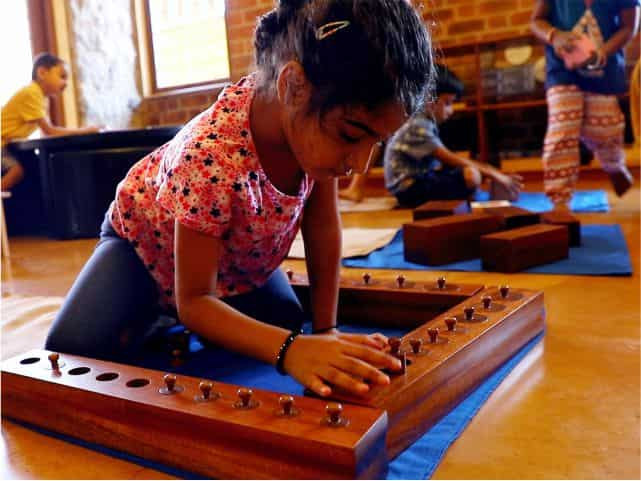
Isolation of Stimulus
Each of the materials is designed to help the child’s mind focus on some particular quality, such as length, color, texture or pitch. For example, the red rods are all of the same color, the same breadth and width, made of the same wood, and vary only in length. The activity the child does with each of the materials, furthermore, can only be done with reference to that quality: the rods are ordered by their length; the sound cylinders paired by the sound they make when shaken, and the color tablets are grouped and arranged by their colors and each color’s specific shades.

Self-Correcting Property
The Sensorial Materials are designed such that the “control of error” lies in
the material itself, and not in the teacher. Thus, as the child inserts the knobbed cylinders into
their holes, he himself can see when he mismatched a cylinder – and it is his own intelligence and
observation which leads him to correct himself.
The aim of the exercises is not to teach the child how to place the cylinders, for example, but rather,
to encourage him to observe carefully, and to apply his mind to solving problems. In Dr. Montessori’s
words: “The aim is an inner one, namely, that the child train himself to observe; that he be led to make
comparisons between objects, to form judgments, to reason and to decide; and it is in the indefinite
repetition of this exercise of attention that a real development ensues.”
Our teachers are trained to support the child’s discovery. Beyond the initial demonstration and being available to help a child who has questions or needs a refresher on the material, our teachers assist in two specific ways:
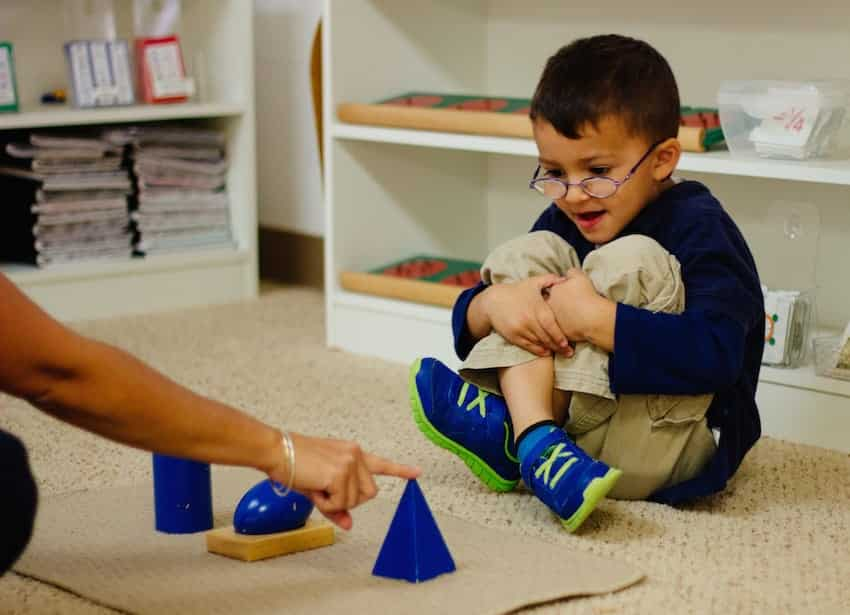
1. Offering Vocabulary
Offering vocabulary to name the concepts learned: the Three Period Lesson. Throughout the Montessori classroom, our teachers play an important role in helping our students to put into words the knowledge they derive from their work with the materials. The teacher observes her students working with a material, and, in the words of Dr. Montessori, “when the child has recognized the differences between the qualities of the objects, the teacher fixes the idea of this quality with a word.” She does so in a systematic process called the Three Period Lesson. First, she names an object or attribute—”This is long. This is short.” Second, she asks the child to hand her the corresponding object, and thus verifies whether he has understood the concept: “Give me the long rod. Give me the short rod.” Finally, she asks the student to pronounce the word, by holding up the object and asking him: “What is this?” Thus, children learn to use language precisely: They understand, implicitly, that concepts are not woozy approximations or mere conventions, but precise identifications of specific things or qualities in reality.
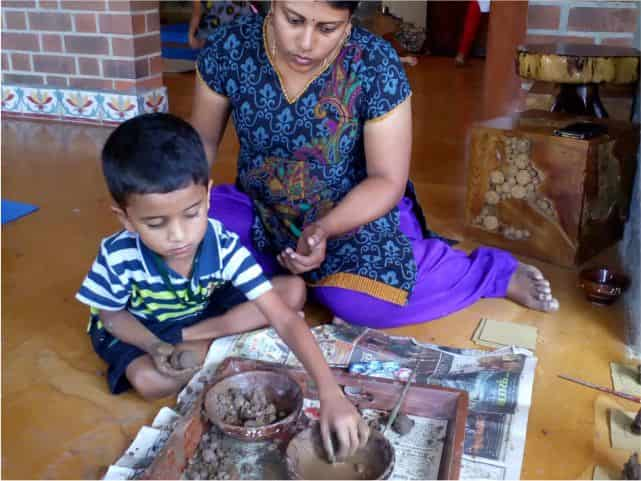
2. Enabling concentration
Enabling concentration by knowing when not to interfere. Dr. Montessori
recognized that a child’s work is real work – and that the child will lose all interest if an
adult interrupts her at an inopportune moment. In her words: “The interest of the child is not
the mere task, but conquering that difficulty. If the teacher is going to conquer it instead,
well let her, my interest is done. … The great principle which leads to the success of the
teacher is this: as soon as concentration appears, pay no attention, as if the child did not exist.”
Thus, in well-run Montessori classrooms such as ours, you will often observe the children
working independently, busily, quietly – with the directress observing carefully, but acting only when she
is actually needed. This is also why we structure our day around extended, 2-3 hour work periods:
we want to make sure the child has time to settle in, to concentrate, without the fear of being
interrupted at any given moment and ushered along into some group activity.
Key Activities
Self-Correcting Materials - Stimulate Careful Observation & Classification of Ideas

The Sensorial Materials consist of a wide range of materials that the children work with independently. Each material is designed to isolate a specific tangible quality of a thing, such as its height, length, color or smell.
Differentiating dimensions and ordering by size.
This group of exercises includes the materials known as the Pink Tower, Brown Stair, Red Rods, and the Knobbed and Knobless Cylinders. The knobbed cylinders, is a set of four oblong blocks of natural colored wood. Each block contains ten cylinder-shaped insets (with knobs on top) that can be removed and reinserted by the child. The cylinders vary in height and width. In one block, only the width changes; in another, the height; in the third, both increase together; and in the forth, the height decreases as the width increases.

A child works with these materials by removing the cylinders, mixing them up, and
replacing them in the proper holes. If he makes a mistake, for example, by placing a thinner cylinder in a
hole that is too big for it, he will discover his error on his own.
In the words of Dr. Montessori: “In the end,
there will be a cylinder left over that cannot be fitted into the still empty hole. . . .
His attention is brought sharply to bear upon an obvious problem. He must take out all the wrongly place
cylinders and put each of them back into its proper place.”
Training all senses to discriminate fine differences.
These materials include the Smelling Jars, the Baric Tablets, the Musical Bells, the Sound Boxes, the Object Bag, the Swatches and the Color Tablets. The Color Tablets, for example, are a set of small wooden rectangles covered in different shades of colors, contained in two boxes each containing sixty four colors, that is, eight different tints, each of which has eight shades graded from lightest to darkest. Initially, the teacher offers a few bright shades for the child to pair. Next, the child progresses to pairing a dozen shades, then to sorting all sixty-four in neatly arranged rows of gradation—and later, to picking out one particular shade and finding something in his environment that corresponds exactly to it.
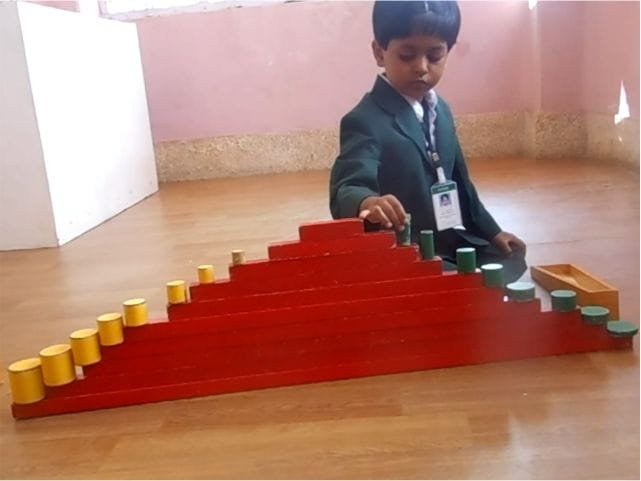
As his skill in identifying and grouping colors improves, so his attentiveness to his
environment increases, and the joy he receives from the exercise multiplies.
Dr. Montessori observes:
“The children are very fond of this exercise in ‘color memory’; it makes a lively digression for them,
as they run with the image of a color in their minds and look for its corresponding reality in their
surroundings. It is a real triumph for them to identify the idea with the corresponding reality and
to hold in their hands the proof of the mental power they have acquired.”
Understanding basic geometrical shapes and solids.
The geometry materials in our primary classrooms include a set of wooden geometric solids (such as spheres, cylinders and prisms); the geometric cabinet (which includes flat wooden insets representing different types and sizes of geometric shapes, such as triangles, rectangles and circles), and constructive triangles (flat triangles of different sizes with which the child can construct all manner of straight-lined geometrical shapes). Our students handle these shapes, learn their names (such as “rectangular prism”) as part of their vocabulary work, and thus build a concrete foundation for the later study of geometry: it is much easier for a child to understand what a prism is when she can hold it in her hand.
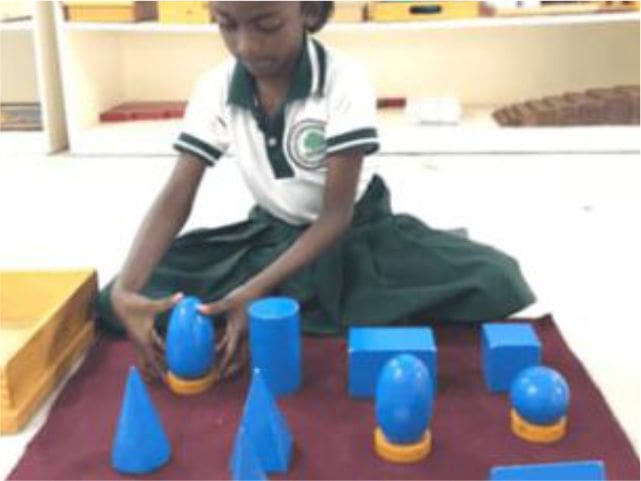
The Results
Active Minds, Concentration Skills and Independent Thinkers
By working with the Sensorial Materials, Vruksha – International School of Montessori students acquire the mental skills and habits which enable them to learn readily and joyfully for the rest of their lives. The materials do not offer the child the content of the mind, but order for that content, and enable them to learn and practice a systematic process for paying attention, observing, comparing and classifying. Through the Three Period Lessons, the child fixes the ideas he has acquired in his mind by means of exact, specific words.
As a result, in Dr. Montessori’s words: Children are able to “find themselves,”
alike in the world of objects and of words which surround them, for they have an inner guide
which leads them to be active and intelligent explorers instead of wandering wayfarers in
an unknown land.
By the time they graduate from our preschool program at age 5 ½ to 6 ½, our students have
acquired the fundamental skills for a lifetime of learning. They are sensitized to external
observation. They learn to observe carefully, and as a result habituate the capacity to take
in information about the world. They have the mental discipline and stamina to see a cognitive
process through to its end. And, as a result, they have an inner confidence in the power of
their mind, and a deep desire to apply that mind in action, a desire which fuels a lifetime
love of learning.
Specifically, our 6-year-olds have learned, practiced and habituated:
Concentration and focusThe ability to actively work with a material for 30, 45, 60 minutes or even longer, without needing adult supervision or help. |
Finely-tuned powers of observationThe ability to differentiate slight gradations of size, color, sound, musical pitch, smell, weight, texture, and a habituated awareness of the external world. |
Persistence, a pro-effort attitude and problem-solving skillsThe confidence in her own ability to solving problems, by exerting effort and staying with a challenge until she masters it; and the pleasure of repeatedly experiencing a challenging problem solved by her own efforts. |
A conceptual approach to the worldThe ability to form abstractions, such as the concept of length, or circle, or musical pitch, and the mental habit of filing knowledge in her mind in useful, accessible categories. |
Reality-focused, independent thinkingThe predisposition to look to the world, not to people, for answers – that is, the understanding that a problem does have a solution, and that he can solve it, but that he must look for the answer in the nature of the things he deals with, not in his or other people’s feelings.. |
Get in Touch with Us
Our Headquarters are in Chennai and Puducherry
27-28, 2nd Cross
Moogambigai Nagar
Reddiarpalayam, Pondy - 605 010
Phone: +91 9994851951
Phone: +91 9361919996
Email: contact@vrukshamontessori.com
24-25, 12th Cross
Ranga Reddy Gardens
Neelankarai, Chennai - 600 041
Phone: +91 9994851951
Phone: +91 9361919996
Email: contact@vrukshamontessori.com
We are social
Click For
Contact Us
